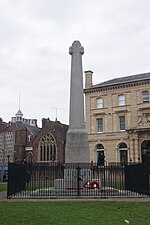St Petrock's Church, Exeter
Church of England church buildings in DevonChurches dedicated to St PetrocChurches in ExeterDevon building and structure stubsEnglish church stubs ... and 2 more
Grade II* listed churches in DevonUse British English from November 2017

St Petrock's Church is a small church in the centre of Exeter with an interior described by Nicholas Pevsner as "among the most confusing of any church... in England". The church may have been founded as early as the 6th century, but other sources date it to the 11th century. William the Conqueror directed the City Provost to pay it one silver penny out of the public taxes, along with 29 other churches. The current building dates originally from early medieval times and is dedicated to St Petrock, who was a 6th-century Roman Catholic Welsh abbot who was later granted the title of saint by the Vatican.
Excerpt from the Wikipedia article St Petrock's Church, Exeter (License: CC BY-SA 3.0, Authors, Images).St Petrock's Church, Exeter
Cathedral Yard, Exeter St Thomas
Geographical coordinates (GPS) Address External links Nearby Places Show on map
Geographical coordinates (GPS)
| Latitude | Longitude |
|---|---|
| N 50.7227 ° | E -3.5322 ° |
Address
St Petroc's
Cathedral Yard
EX1 1HJ Exeter, St Thomas
England, United Kingdom
Open on Google Maps











